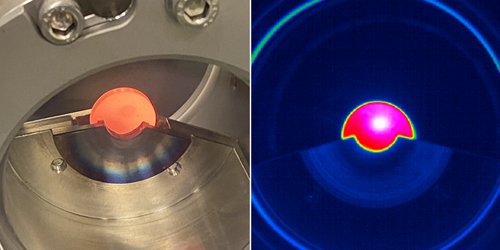• Physics 17, s25
A radiometry technique directly measures thermal conductivity in molten metals and confirms the relationship with electrical resistivity.
P. Hopkins/University of Virginia
It’s hard to measure the thermal conductivity of metals at ultrahigh temperatures and in their molten states. It’s so hard, in fact, that rather than directly measuring this property in high-temperature solids, scientists tend to rely on the empirical Wiedemann-Franz law from 1853, which predicts thermal conductivity from electrical resistivity measurements. Milena Milich and Hunter Schonfeld at the University of Virginia and their colleagues have now made the first direct thermal conductivity measurement for nature’s highest-melting-temperature metal: tungsten [1]. Their novel technique not only offers a tool for examining the thermodynamic properties of metals at ultrahigh temperatures without relying on electrical proxies but also provides a means to validate the Wiedemann-Franz law for molten materials.
The researchers used a gradually intensifying laser beam to heat the center of a 2-mm-thick tungsten disk until it began to melt. While they heated the disk, they measured the emitted radiation to determine the temperature of the hot spot. As this region warmed from 2000 to 4000 K (just above tungsten’s melting point), they tracked the incremental temperature change that resulted from each small increase in the laser’s power. From these measurements, a simple calculation provided the thermal conductivity for tungsten at different temperatures. The values matched those in the literature derived from electrical resistivity.
Simulations showed that thermal conductivity is dominated by contributions from electronic transport rather than from phonon vibrations—confirming the accuracy of electrical resistivity as a predictor. This confirmation means that researchers can have confidence in using easier-to-obtain resistivity measurements at the ultrahigh temperatures required for applications in, for example, nuclear fusion and additive manufacturing.
–Rachel Berkowitz
Rachel Berkowitz is a Corresponding Editor for Physics Magazine based in Vancouver, Canada.
References
- M. Milich et al., “Validation of the Wiedemann-Franz law in solid and molten tungsten above 2000 K through thermal conductivity measurements via steady-state temperature differential radiometry,” Phys. Rev. Lett. 132, 146303 (2024).




